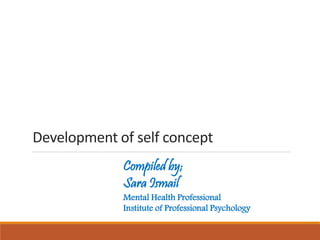
Development of self concept across the life span
- 1. Development of self concept Compiled by; Sara Ismail Mental Health Professional Institute of Professional Psychology
- 2. Self-Understanding Self — All characteristics of a person ◦ Self-understanding, self-esteem, self-concept The Self
- 3. Self-Understanding Cognitive representation of the self, substance of self conceptions Visual self-recognition tests infants Young children perceive self as external characteristics Older children recognize difference between inner and outer states The Self
- 4. Self-Recognition in Infancy Fig. 11.1
- 5. Early Childhood Self-understanding ◦ Confusion of self, mind, and body ◦ Self-descriptions are physical, concrete, active, and unrealistic positive overestimations Understanding others ◦ Individual differences in social understanding linked to caregivers The Self
- 6. Early and Late Childhood Self-understanding: 5 key changes ◦ Internal characteristics emphasized ◦ More referencing in social descriptions ◦ More use of social comparisons ◦ Distinguish between real self and ideal self ◦ Realistic in self-evaluations Understanding others ◦ Increased perspective taking The Self
- 7. Self-Understanding in Adolescence Abstract and idealistic Self-conscious; preoccupied with self Contradictions within the self – multiple roles in different contexts realized Fluctuating self over time and situations Compare real and ideal selves ◦ Possible selves: what persons may be, would like to be, and are afraid of becoming Self-integration in sense of identity The Self
- 8. Changes in Self-Understanding in Adulthood Self-Awareness ◦ Awareness of strengths and weaknesses ◦ Improves in young and middle adulthood Possible Selves ◦ Get fewer and more concrete with age ◦ Some revise throughout adulthood Life Review ◦ Some in middle age, common in older adults ◦ Evaluations of successes and failures The Self
- 9. The Role of Perspective-Taking Perspective-taking — ability to assume another’s perspective and understand his or her thoughts and feelings Important in children developing prosocial and antisocial attitudes and behaviors Affects peer status and quality of friendships The Self
- 10. (Selman, 1980) Perspective Taking ◦ The ability to assume another person’s perspective and understand his or her thoughts and feelings. ◦ Perspective taking develops through five stages, ranging from 3 years of age (the egocentric viewpoint) through adolescence (in-depth perspective taking) ◦ Perspective taking increases self-understanding and improves peer group status and the quality of friendships.
- 12. Self-Esteem and Self-Concept Self-esteem ◦ Global evaluative dimension of the self ◦ Same as self-worth or image Self-concept ◦ Domain-specific evaluations of the self Distinct - not really interchangeable The Self
- 13. Terms of “Self” Self-esteem ~ how much we believe ourselves to be competent, successful, significant, and worthy Self-concept ~ perception of self Self-worth ~ overall value that one places on oneself as a person
- 14. Self-worth Evolves Developmentally Early Childhood • Cannot make meaningful judgments about self-worth. • Have difficulty discerning between cognitive, physical, and social competence. Mid-late Childhood • Begin to make meaningful judgments about self-worth. • Better able to distinguish between constructs of scholastic competence, athletic competence, peer social acceptance, physical appearance, and behavioral conduct. • Physical appearance and social acceptance are most important constructs of global self-worth. Harter, 1988
- 15. Self-worth Evolves DevelopmentallyAdolescenc e • Additional constructs emerge: friendship, romantic appeal, job competence. • Additional major contributors to global self-worth: Parent, friend, classmate, and teacher support. College Age • Global self-worth becomes a function of perceived self-worth in areas most important to the individual. • Additional constructs emerge: intellectual ability, creativity, close friendships, relationships, sense of humor, morality. • Additional major contributors to global self-worth: Intimate relationships, adequacy as a provider. Adulthood • Additional major contributors to global self-worth: Nurturance, house-hold management. Harter, 1988
- 16. Self-Esteem Across the Lifespan Prenatal Development Fig. 11.4
- 17. Self-Regulation Ability to control one’s behavior without having to rely on others for help Includes self-generation and cognitive monitoring of thoughts Self-regulation linked to higher achievement and satisfaction over the lifespan The Self
- 18. Self-Regulation in Infancy and Early Childhood 12-18 months 2-3 years Preschool Depend on caregivers for reminder signals about acceptable behaviors Begin to comply with the caregiver’s expectations in the absence of monitoring Learn to resist temptation and give themselves instructions that keep them focused The Self
- 19. Self-Regulation in Middle/Late Childhood and Adolescence Self-regulation increases from about 5 or 6 years up to 7 or 8 years of age Across elementary school years, children increase beliefs that behavior is result of own effort and not luck From 8 to 14 years of age, children increase perception of self-responsibility for failure The Self
- 20. Selective Optimization with Compensation Successful self-regulation in aging linked to ◦ Selection: reduction in performance ◦ Optimization: continue practice, use of technology ◦ Compensation: concealment; offsetting or counterbalancing a deficiency The Self
- 21. Personal Control Primary control striving ◦ One’s efforts to change external world to fit needs and desires ◦ Attain personal goals, overcome obstacles Secondary control striving ◦ Targets one’s inner worlds: motivation, emotion, and mental representation The Self
- 22. Changes In Primary and Secondary Control Strategies Across the Life Span The Self Fig. 11.6
- 23. Important findings Teachers of young children play a vital role in helping children develop foundational self-regulation skills. Fortunately, young children’s everyday experiences offer abundant opportunities for developing self-regulation. Teachers can take advantage of these opportunities by • identifying each child’s self-regulation zone of proximal development and planning the kinds of modeling, hints, and cues the child needs to continue his or her development, • watching for opportunities in everyday classroom experiences to scaffold self-regulation
- 24. • withdrawing direct support as children begin to demonstrate new skills, and • monitoring children’s activities to ensure they are successful.
- 25. Conclusion When teachers deliberately teach self-regulation as part of everyday experiences, they help children become actively engaged learners, laying the foundation for years of future success in school and life.
